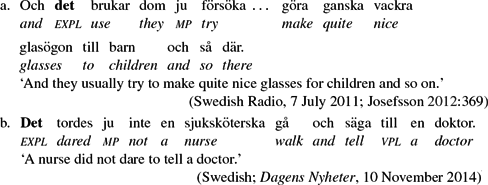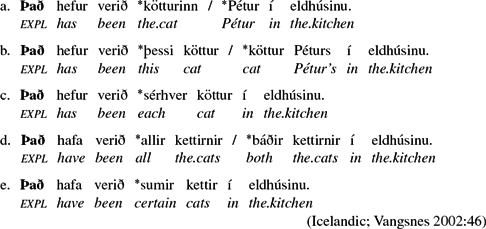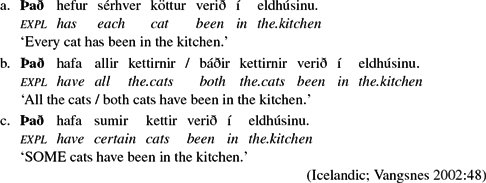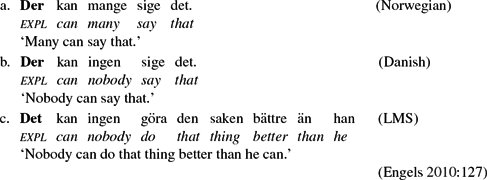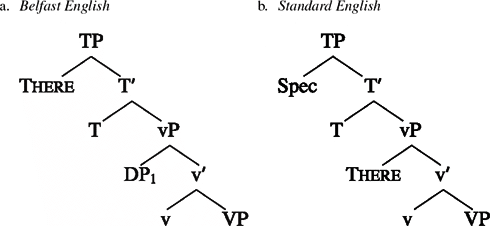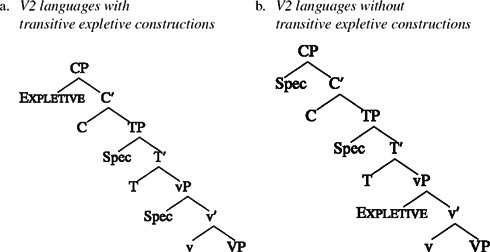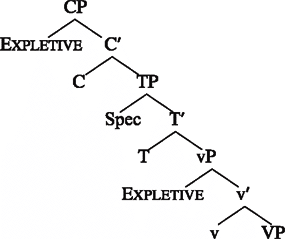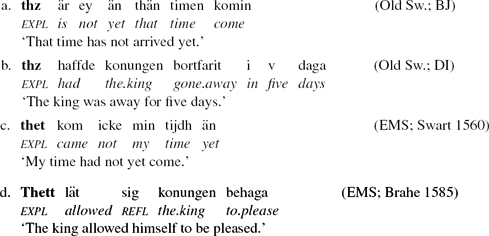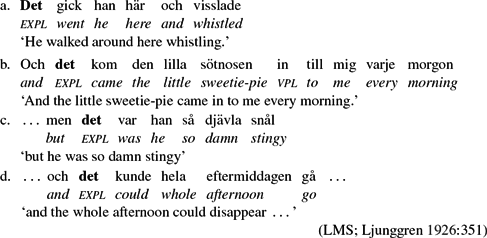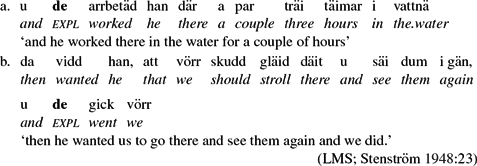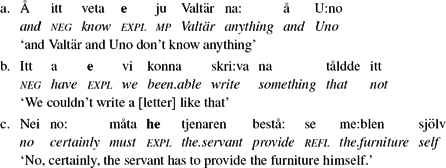1. INTRODUCTION
Ever since interest in comparative syntax took off in the 1980s, expletives have been a central field of research – not least owing to the considerable variation in expletive constructions in the Germanic languages. This variation is particularly evident in the Scandinavian languages; the Insular Scandinavian languages clearly differ from those of Mainland Scandinavia with respect to expletives and expletive pro. Particular attention has been paid to transitive expletive constructions, i.e. constructions containing an expletive followed by an active transitive verb. While active transitive verbs, too, can appear in expletive constructions in Icelandic (and to some extent in Faroese; see Thráinsson et al. Reference Thráinsson, Petersen, Jacobsen and Hansen2004:282), ‘the standard claim is that transitive expletives are not possible’ in the Mainland Scandinavian languages (Thráinsson Reference Thráinsson2007:336). Vikner (Reference Vikner1995) illustrates the difference between Insular and Mainland Scandinavian with the following examples:
-
(1)

Several explanations have been offered to account for the difference between Insular and Mainland Scandinavian demonstrated in (1). Substantially, the point of departure has been conditions in the Scandinavian standard languages, and various morphological and syntactic features, such as verbal agreement and verb movement, have been proposed as licensing transitive expletive constructions, the presence or absence of these features being considered to explain why such constructions occur in Insular but not in Mainland Scandinavian. In addition to accounting for differences between Insular and Mainland Scandinavian, these proposals also have diachronic implications. Although transitive expletives are generally assumed not to exist in the present-day Mainland Scandinavian languages, the proposed licensing factors predict that they will occur in earlier stages of Mainland Scandinavian, and Holmberg & Platzack (Reference Holmberg and Platzack1995:139) show that these predictions are in fact borne out – at least in the sense that Early Modern Swedish allows such constructions:Footnote 1
-
(2)

However, in this article we will argue that the standard claim that transitive expletive constructions are not possible in Mainland Scandinavian cannot be maintained. On the contrary, we will show that these constructions have occurred throughout the history of Swedish and – to some extent – still occur in present-day Swedish. Hence, the difference between Insular and Mainland Scandinavian regarding transitive expletive constructions is not as clear-cut as has generally been assumed, which in turn challenges previous accounts of the phenomenon. The occurrence of constructions of this kind in Swedish suggests that the construction is completely independent of licensing factors such as verbal agreement and verb movement, and in this article we will instead emphasize the lexical inventory of expletive pronouns in a language as crucial. In short, we will claim that transitive expletive constructions are licensed if the expletive pronoun can merge in a position structurally higher than the canonical subject position. In the case of V2 languages, this implies that expletives must be able to merge in Spec,CP, and we will show that expletive pronouns can in fact merge in this position in Swedish. At first glance, such a claim might seem counter-intuitive, since expletive pronouns in Swedish – in contrast to Icelandic – can undoubtedly occur not only in Spec,CP, but also in the canonical subject position to the right of the finite verb, as shown in (3) (from Holmberg & Platzack Reference Holmberg and Platzack1995:100):
-
(3)

We will claim, then, that the lexical inventory of Swedish contains two expletive pronouns: a topic-related expletive, merged in Spec,CP, and a subject-related expletive, merged in Spec,vP. Whereas the higher, topic-related CP expletive was already established in Old Swedish (see Falk Reference Falk1993), the lower, subject-related expletive is an innovation that developed during Early Modern Swedish. Within this perspective, the crucial difference between Icelandic and Swedish as far as transitive expletive constructions are concerned is not related to verbal agreement or verb movement, but rather to the lexical inventory: whereas Icelandic only has a topic-related expletive, Swedish has two expletive pronouns – although today the topic-related CP expletive mainly occurs in spoken Swedish.
The structure of the article is as follows. To begin with, Section 2 discusses how, within the framework of generative grammar, transitive expletive constructions have been traced back to different language-internal licensing factors. Although most of these factors have been discussed from a synchronic point of view, they are also of diachronic relevance, predicting that transitive expletive constructions will occur in earlier stages of Swedish, but not in the present-day language. However, the data in Section 3 show that these constructions have occurred throughout the history of Swedish and to some extent still occur in the present-day language. While transitive expletive constructions are found in both Insular and Mainland Scandinavian, though, there are also clear differences with respect to them between the languages. Section 4 focuses on associate subjects and shows that Swedish is reminiscent of Icelandic in the sense that two positions are available for them, but that – unlike Icelandic – Swedish also allows definite associate subjects in transitive expletive constructions. The presence of transitive expletives in Swedish calls for a new explanation of the phenomenon, and therefore in Section 5 it is claimed that constructions of this type are dependent on the lexical inventory of expletives in a given language. Section 6 discusses whether this analysis applies to Swedish and shows that present-day Swedish in fact has two different expletive pronouns: a topic expletive merged in Spec,CP, and a subject expletive merged in Spec,vP. It may seem impossible to tell whether an expletive pronoun in Spec,CP is merged in this position or not. However, if the expletive can merge in Spec,CP, we would expect expletive pronouns not only to occur in transitive expletive constructions, but to combine with definite associate subjects in general, and we show that these predictions are in fact borne out. Section 7 is a summary of the main conclusions of the article.
2. TRANSITIVE EXPLETIVES – SYNCHRONIC GENERALIZATIONS AND DIACHRONIC IMPLICATIONS
With the introduction of the theory of principles and parameters (Chomsky Reference Chomsky1981), generative research changed from postulating rules for individual languages to comparing syntactic characteristics in different languages. Early on, it was noted that expletive constructions exhibit a high degree of variation in the Germanic languages, and various proposals have been presented to account for this variation. As for transitive expletive constructions, several attempts have been made to present a uniform analysis of the phenomenon. In this section, some of these proposals will be discussed.
The point of departure will be Bures's (Reference Bures1993) claim that in the Germanic languages there is a correlation between object shift and transitive expletive constructions, in the sense that ‘the languages that allow object shift (OS) of full NPs are the same ones that have transitive expletive sentences’ (Bures Reference Bures1993:15). According to Bures (Reference Bures1993), the reason for this correlation is that both constructions involve the raising of two arguments in the same cycle, either at LF (as far as transitive expletive constructions are concerned) or at PF (as far as OS of full DPs is concerned). Bures (Reference Bures1993) does not assume that the associate subject has to leave VP, but supposes that existential sentences ‘involve raising at LF of an argument to adjoin to the expletive’ (Bures Reference Bures1993:14), as shown in (4):
-
(4) [There [two ships] i ] arrived ___ i in the harbor.
Raising of two arguments in the same cycle is only possible in languages that allow A-movement through Spec,TP, as illustrated in the structure in (5).
-
(5) [AgrP NP i Agr [TP ___ i Tense [AgrP NP k Agr [VP ___ i V ___ k ]]]]
If A-movement through Spec,TP is prohibited, the object blocks raising of the subject, ruling out both covert and overt movement of two arguments.
According to Bures (Reference Bures1993), A-movement through Spec,TP is allowed in Icelandic, but not in the Mainland Scandinavian languages, and hence object shift of full DPs is expected to occur only in Icelandic.Footnote 2 That is indeed the case, as shown in (6).
-
(6)

Among the Scandinavian languages, Bures (Reference Bures1993) discusses Icelandic in contrast to Mainland Scandinavian, and if we accept the standard claim that transitive expletive constructions are not allowed in Danish, Norwegian and Swedish, the prediction of his generalization is borne out: transitive expletives and object shift occur in Icelandic, but not in Mainland Scandinavian.Footnote 3 However, the diachronic implications of the generalization are not entirely clear: since there is no evidence that full DP object shift has occurred in the history of Swedish, it is not obvious that A-movement through Spec,TP ever was a possibility in that language. Hence, Bures's generalization cannot account for the fact that transitive expletive constructions were possible in Early Modern Swedish (recall (2) above).Footnote 4
While Bures (Reference Bures1993) correlates transitive expletive constructions with full DP object shift, another correlation has been proposed between transitive expletives and V°-to-T°/I° (henceforth V°–T°) movement. The latter correlation is often referred to as Vikner's generalization, after Vikner (Reference Vikner1995), who argues that transitive expletive constructions are dependent on the V2 phenomenon in combination with V°–T° movement. According to Vikner, the associate subject position can only be case-licensed to the left of the non-finite verb if T° has morphological content. Only in languages with V°–T° movement is T° filled, and transitive expletive constructions are thus only possible in languages showing V°–T° movement. It is well known that Icelandic differs from the Mainland Scandinavian languages in this respect. While all of the Scandinavian languages are V2 languages, they vary with respect to V°–T° movement. Icelandic (and to some degree Faroese – see Bentzen et al. Reference Bentzen, Garbacz, Heycock and Hrafnbjargarson2009 and Heycock et al. Reference Heycock, Sorace, Hansen, Vikner and Wilson2012) shows V°–T° movement, but the Mainland Scandinavian languages do not (at least not to the same extent; see further Wiklund et al. Reference Wiklund, Hrafnbjargarson, Bentzen and Hróarsdóttir2007). The examples in (7) and (8) illustrate:
-
(7)

-
(8)

As shown in (7), in Icelandic subordinate clauses the finite verb moves to the T-domain, whereas in the standard varieties of the modern Mainland Scandinavian languages it remains in situ, as shown in (8). However, the older stages of the Mainland Scandinavian languages follow the pattern of Insular Scandinavian rather than that of their standard modern counterparts in this respect (Falk Reference Falk1993, Sundquist Reference Sundquist2003, Håkansson Reference Håkansson2011, as is shown in (9)).
-
(9)

In the case of Swedish, the old subordinate clause word order with V°–T° movement is gradually replaced in Early Modern Swedish with the modern order without V°–T° movement. This development is shown in Table 1.
Table 1. V°–T° movement in subordinate clauses in Early Modern Swedish.
Source: Falk (Reference Falk1993:176)
According to Falk (Reference Falk1993), V°–T° movement is triggered by verbal inflection, and she argues that V°–T° movement in subordinate clauses in Swedish finally disappears when agreement in number is lost during the 17th century. If, with Vikner (Reference Vikner1995), we assume a connection between V°–T° movement and transitive expletive constructions, we would expect the latter to occur in Swedish as long as V°–T° movement is a syntactic possibility in subordinate clauses, i.e. until the 17th century.
A connection between V°–T° movement and transitive expletive constructions has also been put forward by Bobaljik & Thráinsson (Reference Bobaljik and Thráinsson1998). In contrast to Vikner, however, those authors do not assume a causal relationship between the two syntactic phenomena: rather, they are both regarded as consequences of the same parameter, the split-IP parameter:
-
(10) The split-IP parameter (SIP)
-
If a language has a positive value for the SIP, then it will obligatorily have V-to-I movement and it will also have an ‘extra’ subject position available (and possibly also an extra object position).
-
(Thráinsson Reference Thráinsson2009:6)
Bobaljik & Thráinsson (Reference Bobaljik and Thráinsson1998) argue that the (standard) Mainland Scandinavian languages have a negative value for the split-IP parameter, and that this negative value is the reason for the lack of transitive expletive constructions in Danish, Norwegian and Swedish: given that the associate of the expletive has to leave VP, there is no position available for it in the T-domain, since this position is already occupied by the expletive. In Icelandic on the other hand, the split-IP parameter has a positive value and from this it follows that transitive expletive constructions occur: even if the expletive occupies a position in the T-domain, there is still a position available for its associate. As in much of the generative syntactic research of the 1990s, Bobaljik & Thráinsson (Reference Bobaljik and Thráinsson1998) assume a relationship between overt morphology and parameter setting, and as far as the split-IP parameter is concerned, the expression of both tense and agreement by discrete morphemes (as Icelandic kasta-ði-r ‘throw-past-sg.2’ or köstu-ðu-m ‘throw-past-pl.1’) results in a positive value of the parameter.
In the history of the Mainland Scandinavian languages, too, tense and agreement were expressed by discrete morphemes – at least in the past tense plural, see (11) below for Old Swedish – and hence we would expect Old Swedish to have an internal structure of the T-domain that patterns with Icelandic rather than with the standard modern Mainland Scandinavian languages.
-
(11)

As shown in (11), Old Swedish retained a morphological system in which finite verbs agreed in number and person with the subject. Whereas the singular forms were non-distinct, in the plural all persons were distinct (Wessén Reference Wessén1965:122). In Late Old Swedish (approximately in the 15th century in the dialects of central Sweden), agreement in person was weakened by the use of common forms. If the internal structure of the T-domain is dependent on verbal inflection, we would expect the value of the split-IP parameter to have changed in Swedish during the 15th century, and if – like Bobaljik & Thráinsson (Reference Bobaljik and Thráinsson1998) – we assume a connection between the internal structure of the T-domain and transitive expletive constructions, we would expect the latter to occur in Swedish as long as the split-IP parameter is set positively, i.e. until the 15th century. After that, tense and agreement are no longer expressed by discrete morphemes, and hence there is no longer an ‘extra’ subject position in the T-domain.
To summarize, several factors have been proposed as licensing transitive expletive constructions and accounting for the difference between Mainland and Insular Scandinavian in this respect. Although the main focus of these theories is synchronic, they all have implications for the history of Swedish and make predictions for the diachronic development of the phenomenon: we expect transitive expletives to occur in Old Swedish and Early Modern Swedish, but not thereafter, if the predictions of earlier synchronic generalizations are borne out. In the next section, these predictions will be tested against data from the history of Swedish.
3. EXPLETIVES IN SWEDISH
As shown above, it is generally assumed that transitive expletives do not exist in the modern Mainland Scandinavian languages. In earlier stages of Swedish, however, they do occur (as is shown in (2) above). Although it is clear from previous research that transitive expletive constructions have occurred in the history of Swedish, to the best of our knowledge no detailed diachronic investigation of the phenomenon has been undertaken. To fill this gap, this section presents results from an empirical study of transitive expletive constructions in the history of Swedish. In sum, these results show that such constructions were possible in written Swedish until the 19th century, but subsequently seem to have been restricted to the spoken language. This finding is highly unexpected in the light of earlier research indicating that transitive expletive constructions are not possible in the Mainland Scandinavian languages.Footnote 5
Following the theoretical proposals discussed in the previous section, we would expect transitive expletives to occur in Old Swedish and Early Modern Swedish, but not thereafter. However, the predictions of such a hypothesis are in fact very difficult to test – at least as far as Old Swedish is concerned, since it generally provides very few instances of expletives. In a study of existential sentences in Old Swedish, Varho [Sandelin] (Reference Varho [Sandelin]1995) shows that more than 99% of such sentences from Early Old Swedish (prior to 1375) lack an expletive pronoun. In Late Old Swedish (after 1375), the use of such pronouns increases, especially in religious texts, but even so the mean proportion of existential sentences with overt expletive pronouns does not exceed 10% in any genre (Varho [Sandelin] Reference Varho [Sandelin]1995:168). Although the frequency of expletive pronouns is low in Old Swedish, active transitive verbs with an overt expletive can be attested, as shown by Söderwall, Ljunggren & Wessén (Reference Söderwall, Ljunggren and Wessén1953–73:960):
-
(12)

During Early Modern Swedish the use of overt expletive pronouns continues to increase (Falk Reference Falk1993). However, in combination with active transitive verbs, expletives are still quite rare. In the Swedish Bible translation from 1541, there are some examples (see (13a)), but in other Early Modern Swedish texts only isolated instances can be attested (see (13b)):
-
(13)

As for Late Modern Swedish, Olson (Reference Olson1913) and the Swedish Academy dictionary SAOB (1910:D824) give a few examples of expletives combined with transitive verbs (see (14) below), but according to Olson (Reference Olson1913) expletive pronouns are unusual in this context, and judging from SAOB expletive pronouns have occurred in combination with transitive verbs in Swedish, but nowadays (i.e. in 1910) they are hardly used. The latest examples given by SAOB, in (15), are from the 1840s.
-
(14)

-
(15)

Interestingly, however, although transitive expletive constructions occur rather sparingly in the written language throughout the history of Swedish, Ljunggren (Reference Ljunggren1926) reports that they were frequently attested in spoken Swedish around 1900. Some of his examples are given in (16)–(17):
-
(16)

-
(17)

Ljunggren (Reference Ljunggren1926) gives many examples of transitive verbs with expletive pronouns, but it is not clear whether this usage was widespread in contemporary spoken Swedish or restricted to particular dialects. According to Heinerz (Reference Heinerz1930), transitive expletive constructions were unattested in the Scanian dialects, and Wallin (Reference Wallin1936) argues that they mainly occur in south-western Swedish. However, Stenström (Reference Stenström1948) shows that such constructions occur in the traditional dialect of Gotland (see (18) below), while Nordberg (Reference Nordberg, Bäcklund, Börestam and Marttala2004) reports examples from the spoken language of central Sweden, used by informants born around the turn of the past century (see (19)). Overall, there seems to be good reason to believe that, around 1900, expletive pronouns could combine with active transitive verbs in spoken Swedish – completely independently of licensing factors such as verbal agreement and verb movement.
-
(18)

-
(19)

As noted above, the standard view is that expletive pronouns cannot combine with active transitive verbs in present-day Mainland Scandinavian languages. This may be true of the written languages, but in spoken Swedish there are undoubtedly examples of expletive det in combination with an active transitive verb. The examples in (20) below are drawn from the Nordic Dialect Corpus (Johannessen et al. Reference Johannessen, Priestley, Hagen, Åfarli and Vangsnes2009) and were recorded in different parts of Sweden: the north (Anundsjö in the province of Ångermanland), the south (Bara in Skåne), the east (Fole on the island of Gotland), and the central part of Sweden (Villberga in Uppland; Skinnskatteberg in Västmanland), while those in (21) are taken from a newspaper (quoted speech) and a radio broadcast.Footnote 6
-
(20)

-
(21)

Again, the use of expletive pronouns with active transitive verbs in contemporary Swedish cannot be traced back to licensing factors such as verbal agreement and verb movement, since those factors are more or less absent in present-day speech.
In a Scandinavian context, the term ‘transitive expletive construction’ is normally used to refer to a transitive verb in combination with an expletive pronoun and an indefinite associate subject (as in (1a) above – repeated here as (22)). However, the Swedish examples discussed in this section include a broader repertoire of associate subjects with definite associate subjects in majority. From an Icelandic point of view, this is an unexpected pattern. At the same time, it has to be emphasized that the Swedish instances of transitive expletive constructions are not unique. In German, too, active transitive verbs can combine with expletive pronouns and a definite associate, as will be further discussed in the next section.
-
(22)

Since both definite and indefinite associate subjects show the same diachronic development in Swedish, there is no reason to believe that they represent different constructions. In other words, there is no need to reserve the term ‘transitive expletive construction’ for sentences with indefinite associate subjects, and if the term is used in this broader sense, it is clear that transitive expletive constructions have occurred throughout the history of Swedish. The empirical investigation presented in this section has also provided evidence that transitive expletives are a feature of present-day Swedish, contrary to the standard claim that they are not possible in Mainland Scandinavian.Footnote 8 In fact, there is no change over time as far as transitive expletive constructions in Swedish are concerned, although from around 1900 there is a clear demarcation between the spoken and the written language: in present-day Swedish, transitive expletives are practically unattested in writing, but still possible in speech. Taken together, the results of this investigation give reason to question not only the view that transitive expletive constructions do not occur in Mainland Scandinavian, but also the diachronic implications of the synchronic generalizations made: the fact that present-day Swedish does not show any of the features put forward as licensing transitive expletives points strongly to a need for a new explanation of the phenomenon.
4. THE ASSOCIATE SUBJECT – STRUCTURAL POSITIONS AND THE INDEFINITENESS REQUIREMENT
The point of departure of this article has been differences among the Scandinavian languages with respect to expletive constructions. In the previous section, it was shown that expletive pronouns could combine with active transitive verbs in Swedish, and this finding highlights another difference between Insular and Mainland Scandinavian related to expletive constructions: the positions and form of the associate subject.
In Icelandic, the associate subject can occur in different positions, either to the left or to the right of the non-finite verb:
-
(23)

Although Icelandic has two positions for associate subjects, Vangsnes (Reference Vangsnes and Svenonius2002) shows that these different positions allow different types of nominal phrases. Much as in English and Mainland Scandinavian, associate subjects in the postverbal position in Icelandic are subject to the definiteness effect, ruling out definite descriptions (24a–b), universally quantified noun phrases (24c–d) and partitive noun phrases (24e) from this position:
-
(24)

The intermediate position, to the left of the non-finite verb, on the other hand, is not subject to the definiteness effect, since noun phrase types that are excluded in the postverbal position, such as universally quantified and partitive noun phrases, can occur in the position before the non-finite verb, as shown in (25) below. However, definite noun phrases are excluded from the intermediate position as well, as shown in (26) (if they are not embedded in a universally quantified noun phrase, as in (25b–c)).
-
(25)

-
(26)

With respect to transitive expletive constructions, the intermediate position is of particular interest, since associate subjects in such constructions can only occur in this position:
-
(27)

It is widely acknowledged that Icelandic differs from Mainland Scandinavian with respect to the structural positions available for associate subjects, and it has been argued that only the postverbal position is available for such subjects in Mainland Scandinavian (see Vangsnes Reference Vangsnes and Svenonius2002 among others). However, Engels (Reference Engels2010) has shown that, around 1900, the intermediate position was also available in the Mainland Scandinavian languages, although, she claims, only quantified and negative associate subjects could occur in this position:
-
(28)

However, the data presented in Section 3 above give reason to question Engels's (Reference Engels2010) claim that the intermediate position allowed only quantified and negative associate subjects, at least as far as Swedish is concerned.Footnote 9 On the contrary, those data may indicate that there is an intermediate position for associate subjects in Swedish and that it is not restricted to those that are quantified or negative, since definite associate subjects can also occur in this position – both in the history of Swedish and in the present-day language. Whereas in Icelandic associate subjects in the intermediate position cannot be definite (see (29b) below), this is clearly an option in Swedish, as shown in (29a). Hence, the conclusion – contrary to what is standardly claimed – is that at least some varieties of Swedish have two positions for associate subjects, and that associate subjects in the intermediate position are immune from the definiteness effect. (In (29a), the symbol % marks idiolectal and dialectal variation.)
-
(29)

Thus, in this respect, Swedish patterns not with Icelandic but with German, where definite associate subjects are also possible (see Barðdal & Eythórsson Reference Barðdal and Eythórsson2003 and references cited there):
-
(30)

According to Barðdal & Eythórsson (Reference Barðdal and Eythórsson2003:769), it ‘seems that some pragmatic factors rather than definiteness are responsible for the restrictions on the co-occurrence of an expletive and a subject in German’, and the same can also be said to hold for Swedish: pragmatic factors rather than definiteness determine whether expletive pronouns can combine with an associate subject and a transitive verb.
To conclude, it has been argued in this section that Swedish has two positions available for the associate subject. In this sense, it is reminiscent of Icelandic, but unlike Icelandic, Swedish – just like German – also allows definite associate subjects in the intermediate position.
5. STRUCTURAL POSITION(S) OF THE EXPLETIVE
The presence of transitive expletive constructions in Swedish challenges earlier accounts of the phenomenon, since present-day Swedish does not show any of the different morphological and syntactic features, such as verbal agreement and verb movement, that have been proposed as licensing transitive expletive constructions. A new explanation for the phenomenon is therefore needed, and in this section we will launch the hypothesis that transitive expletive constructions are dependent on the lexical inventory of expletive pronouns in a given language. In short, we will claim that these constructions are licensed if the expletive pronoun can merge in a position structurally higher than the canonical subject position. In the case of V2 languages, this implies that expletives must be able to merge in Spec,CP. The central idea goes back to Platzack (Reference Platzack and Karlsson1983), who argues that transitive expletive constructions are possible in languages where the expletive does not show syntactic subjecthood (such as Icelandic and German), but impossible in languages where it has the syntactic status of a subject. Expressed in more contemporary terms, Platzack's (Reference Platzack and Karlsson1983) analysis sets out from the assumption that only when the expletive is merged in the sentence-initial position is the subject position empty and the associate subject thus able to occupy that position. If the expletive is a subject pronoun, on the other hand, it is base-generated in the subject position and therefore there is no empty position in the structure for the associate subject. For the Scandinavian languages, similar analyses have since been put forward by Maling (Reference Maling1988) and Christensen (Reference Christensen1991a, Reference Christensenb).Footnote 10 More recently, Henry & Cottell (Reference Henry and Cottell2007) have proposed a similar approach to account for transitive expletive constructions in Belfast English. According to those authors, whereas such constructions are ungrammatical in Standard English, they do exist in Belfast English, as shown in (31):
-
(31)
-
a. There have lots of people eaten their lunch already.
-
b. There shouldn't anybody drink wine before dinner time.
-
Henry & Cottell (Reference Henry and Cottell2007) argue that expletives in Belfast English are merged in a higher structural position than in Standard English, and hence there are positions available both for the expletive and the associate subject in Belfast English, but not in Standard English:Footnote 11
-
(31)

If the analysis suggested by Henry & Cottell (Reference Henry and Cottell2007) were to be applied to V2 languages, it might be proposed that the expletive merges in Spec,CP in languages allowing transitive expletive constructions, but in Spec,vP in languages in which such constructions are not allowed. See (32a) and (32b):
-
(32)

Since, as shown above, transitive expletive constructions occur in both Insular and Mainland Scandinavian (at least in Swedish), one would expect the structure in (32a) to be the appropriate one in these languages. However, it is well known that Icelandic differs from the Mainland Scandinavian languages as far as the placement of expletive pronouns is concerned. In Mainland Scandinavian the expletive can occur to the right of the finite verb, whereas in Icelandic it can never do so, as shown in (3) above, here repeated as (33). Thus, there seems to be good reason to believe that (32a) cannot be the correct analysis for all V2 languages that allow transitive expletive constructions.
-
(33)

A common way of handling the difference between Mainland and Insular Scandinavian illustrated in (33) is to assume that the expletive in Icelandic is some sort of a placeholder, merged in a different position than expletive subjects in Mainland Scandinavian. Biberauer (Reference Biberauer, Biberauer, Holmberg, Roberts and Sheehan2010) has argued that, in the Scandinavian languages, expletives are merged either in Spec,CP (Icelandic) or in a lower structural position (Mainland Scandinavian), but she suggests that there are languages, such as German and Dutch, where they can merge in either the higher or the lower structural position. For German, Biberauer (Reference Biberauer, Biberauer, Holmberg, Roberts and Sheehan2010) points to the fact that quasi-arguments can occur to both the left and the right of the finite verb (see (34)), whereas non-argumental expletives are never overtly realized to the right of the finite verb, as shown in (35).Footnote 12
-
(34)

-
(35)

Since non-argumental and quasi-argumental expletives show different properties with respect to word order, Biberauer (Reference Biberauer, Biberauer, Holmberg, Roberts and Sheehan2010) claims that expletives in German can be merged either in Spec,CP (non-argumental es) or in Spec,vP (quasi-argumental es). Here, we will propose a similar analysis to account for transitive expletive constructions in V2 languages in general, and as far as the Scandinavian languages are concerned we will claim that expletives can merge in two different positions: either as a topic expletive in Spec,CP or as a subject expletive (non-argumental or quasi-argumental) in Spec,vP. In Icelandic, only the former position is possible, whereas in present-day Swedish, expletives can merge either in Spec,CP or in Spec,vP (although nowadays CP expletives are restricted by certain idiolectal factors):
-
(36)

When the expletive is merged in Spec,CP, a position is available for the associate subject in the T-domain, which enables transitive expletive constructions. However, if the expletive is merged in Spec,CP, we would not expect the expletive pronoun in transitive expletive constructions to occur to the right of the finite verb, in contrast to subject expletives, and in fact this prediction seems to be borne out: according to Ljunggren (Reference Ljunggren1926:344), an expletive element is only possible in clause-initial position together with a transitive verb. In our judgement, transitive expletives are not possible either in main clauses with a non-subject topicalized or in subordinate clauses, i.e. in the canonical subject position, an assessment that is confirmed by the fact that we have found no instances of expletive pronouns in combination with transitive verbs in the canonical subject position.Footnote 13 In this respect, the Swedish transitive expletive differs from other expletive pronouns in Swedish and instead behaves in same way as expletives in transitive constructions in Icelandic or German – occurring only to the left of the finite verb in main clauses (Engels Reference Engels2010:103):
-
(37)

-
(38)

In this section, we have launched the hypothesis that the occurrence of transitive expletive constructions is dependent on the structural position of the expletives in a given language; furthermore, we have claimed that present-day Swedish in fact has two different expletive pronouns: a topic expletive merged in Spec,CP, and a subject expletive merged in Spec,vP. In the next section, the predictions of this hypothesis will be further tested.
6. TWO EXPLETIVE PRONOUNS IN SWEDISH?
In the previous section, it was claimed that the expletive could merge in two different positions in present-day Swedish, either in Spec,CP or in Spec,vP. Such an analysis may account for the variation in present-day Swedish, where expletive pronouns in transitive constructions only occur to the left of the finite verb in main clauses, whereas other expletives can also appear in other positions, i.e. to the right of the finite verb in main clauses and after the complementizer in subordinate clauses. However, it is doubtful whether this analysis also applies to Old Swedish, since expletives in Old Swedish are generally restricted to Spec,CP.
As already mentioned in Section 3 above, there are very few instances of expletive pronouns in Old Swedish, but where one does occur it appears almost exclusively in sentence-initial position in main clauses. In an extensive study of existential clauses in Old Swedish, Varho [Sandelin] (Reference Varho [Sandelin]1995) found only three instances of expletive pronouns that do not follow this pattern: in these cases, the expletive occurs to the right of the finite verb in a main clause, as shown in (39).
-
(39)

As for subordinate clauses, expletive pronouns mainly seem to occur in clauses where topicalization is possible. Since clauses like (40) can show main clause word order, they do not represent counter-evidence to the analysis of expletive det as merged in Spec,CP:
-
(40)

In subordinate clauses where topicalization is more or less ruled out, however, there are very few instances of expletive det. According to Falk (Reference Falk1993:254) ‘[s]ome examples’ can be found, but in Old Swedish we are aware of only one (Jörgensen Reference Jörgensen1987:135):
-
(41)

To conclude, there appears to be quite strong evidence that expletive pronouns in Old Swedish are merged in Spec,CP only. For Icelandic það, a similar analysis has been proposed. Although the analysis of Icelandic það as some sort of placeholder merged in Spec,CP may have its advantages, it has also been questioned (see further Hornstein Reference Hornstein1991 and Thráinsson Reference Thráinsson2007), on two grounds. Firstly, það can also occur in embedded clauses. Since topicalization is possible in some embedded clauses in Icelandic, just as in Old Swedish, this may at first glance seem unproblematic, but in fact það can be inserted even in embedded clauses where topicalization is more or less impossible, as shown in (42).
-
(42)

Secondly, expletive það can occur in wh-clauses, as shown in (43). If það is merged in Spec,CP, this would be unexpected, since this position is often assumed to be blocked by the wh-operator:
-
(43)

However, even if these objections are relevant to the analysis of expletive það in Icelandic as some sort of placeholder, merged in Spec,CP, they may be less so when it comes to the syntactic status of expletive det in the history of Swedish, since there seems to be quite strong evidence that expletives in Old Swedish could only merge in Spec,CP. In Early Modern Swedish, however, the use of expletive pronouns increases, as shown in Table 2, and Falk (Reference Falk1993) argues that this increase reflects a change in their syntactic status: according to her, after 1600 expletive pronouns are no longer placeholders in Spec,CP, but represent true syntactic subjects in Swedish. In different terms, this change can be interpreted as expletives in Swedish no longer merging in Spec,CP, but rather in Spec,vP.
Table 2. Expletive det in expletive constructions in Early Modern Swedish.

Source: Falk (Reference Falk1993:235)
As argued above, however, there may be reason to doubt that expletives are always syntactic subjects in Swedish post-1600: the occurrence of transitive expletive constructions throughout the history of Swedish suggests that expletives can continue to merge in Spec,CP, even after that date. We would therefore suggest that a system of vP expletives does not replace the earlier system of expletive pronouns as some sort of placeholders merged in Spec,CP. In fact, we would argue that a lexical inventory of two different expletives arose in Swedish after the introduction of expletive subjects around 1600, as shown in (44):
-
(44)

However, if pragmatic factors rather than definiteness are responsible for the restrictions on the co-occurrence of an expletive and an associate subject in Swedish, we would expect expletive pronouns to occur in Spec,CP not only together with associate subjects of transitive verbs, but with definite associate subjects in general. According to Falk (Reference Falk1993:263), such constructions do occur in Early Modern Swedish, as shown in (45), but are ‘very rare’:
-
(45)

Although the construction is rare, expletive det clearly can occur together with definite associate subjects in general – throughout the history of Swedish. Some Old and Early Modern Swedish examples are given in (46):
-
(46)

In Late Modern Swedish the use of expletive det with definite associate subjects seems more restricted. According to SAOB (1910:D824), the construction is no longer possible and the latest examples given are from the 18th century. One of these examples is given in (47):
-
(47)

Although expletive det rarely seems to combine with definite associate subjects in written Swedish after the 18th century, Ljunggren (Reference Ljunggren1926) reports examples of the construction from the contemporary spoken language:
-
(48)

Stenström (Reference Stenström1948) and Nordberg (Reference Nordberg, Bäcklund, Börestam and Marttala2004) report similar examples (see (49) and (50 below)), and searches that we have conducted in the Nordic Dialect Corpus (Johannessen et al. Reference Johannessen, Priestley, Hagen, Åfarli and Vangsnes2009) indicate that expletive det can still combine with definite associate subjects – not only with active transitive verbs – as shown in (51).
-
(49)

-
(50)

-
(51)

The occurrence of definite associate subjects in expletive constructions in Swedish resembles the use of topic expletives in German, as in (52) below, and clearly shows that Swedish not only has quasi-argumental and non-argumental expletives, but also a topic expletive, merged in Spec,CP.
-
(52)

In this section, we have argued that the possibility of merging expletives in vP was an innovation that developed during Early Modern Swedish, whereas expletives could merge in Spec,CP as early as in Old Swedish. However, when expletives began to merge in vP during Early Modern Swedish, a lexical inventory of two expletive pronouns arose in Swedish, as the old system of CP expletives was not completely replaced by a new system of vP expletives. On the contrary, the data presented above clearly show that CP expletives have continued to occur side by side with vP expletives in Swedish.
7. SUMMARY
It is generally assumed that transitive expletive constructions do not exist in Mainland Scandinavian. In this article, we have shown that that view cannot be maintained – at least not for Swedish. Throughout the history of Swedish, transitive expletive constructions do occur – contrary to the standard claim that they are not possible. Although this article has been confined to a particular construction, its findings may be of broader relevance. Within the framework of generative grammar, the presence or absence of transitive expletives has been explained internally, by relating the construction to licensing factors such as verb movement and verbal agreement. However, these factors appear to be completely irrelevant to the presence of transitive expletives in Swedish, and it thus seems doubtful whether these constructions can be included in a morphology-driven parametric approach to language variation and change (see Holmberg Reference Holmberg2010). Rather, we have shown that languages such as Swedish, Icelandic and German share the property of a topic expletive, merged in Spec,CP. Hence, the presence or absence of transitive expletive constructions follows directly from the lexical inventory of expletive elements in a given language.
From a diachronic point of view it is interesting that, while transitive expletives still occur in Swedish, the construction is nowadays more or less confined to the spoken language. The reason for this may be puristic: transitive expletive constructions have been regarded as a result of German influence (see Beckman Reference Beckman1918, Wellander Reference Wellander1939). In written languages, certain constructions may be banned, but it is certainly more difficult to force them out of a spoken language. The fact that transitive expletive constructions are restricted to spoken Swedish, or certain varieties of it, and do not occur in the standard language, may also be a reason why they have not previously been observed in Swedish. As Hudson (Reference Hudson, Jacobs, von Stechow, Sternefeld and Vennemann1995:1518) points out, it is ‘all too easy to draw general and fundamental conclusions about the basic structure of a language on the basis of facts which turn out not to apply generally to all dialects of the same language’.
ACKNOWLEDGEMENTS
I am grateful to Cecilia Falk who provided detailed and constructive comments on an earlier version of this article. I would also like to thank the three anonymous reviewers and NJL editor Gunnar Ólafur Hansson for valuable and insightful comments, and NJL copy-editor Ewa Jaworska for helpful suggestions. This research has been funded by a research fellow grant from the Royal Swedish Academy of Letters, History and Antiquities.
SOURCES
Old Swedish
-
BJ = Barlaam och Josaphat. Prosadikter från Sveriges Medeltid, ed. G. E. Klemming, 1887–1889. Stockholm: Norstedt. MS from c. 1442.
-
DI = Sagan om Didrik af Bern, ed. G. O. Hyltén-Cavallius, 1850–54. Stockholm: Norstedt. MS from the late 15th or early 16th century; originally written c. 1450.
-
JS = Speculum Virginium – Jungfruspegel, ed. R. Geete, 1897–98. Stockholm: Norstedt. MS from c. 1500; originally written between 1472 and 1486.
Early Modern Swedish
Texts available electronically via Fornsvenska textbanken (Lund University) or Språkbanken (University of Gothenburg) are marked *.
-
GVB = *[Gustav Vasas Bibel] Nya Testamentet i Gustav Vasas Bibel, ed. N. Lindqvist, 1941. Stockholm: Svenska kyrkans diakonistyrelses bokförlag. Selected books: Gospel of Mark, Gospel of Luke, Book of Revelation. Originally written 1541.
-
Swart = *[Peder Swarts krönika] Konung Gustaf Is krönika, ed. Nils Edén, 1912. Stockholm: Ljus. Originally written c. 1560.
-
Brahe = *[Per Brahes krönika] Per Brahe den äldres fortsättning av Peder Swarts krönika I och II, ed. O. Ahnfeldt, 1896–97. Lund. Originally written c. 1585.
-
Horn = *[Agneta Horns leverne] Beskrivning över min vandringstid, ed. G. Holm, 1959. Stockholm: Almqvist & Wiksell. Originally written c.1657.



















